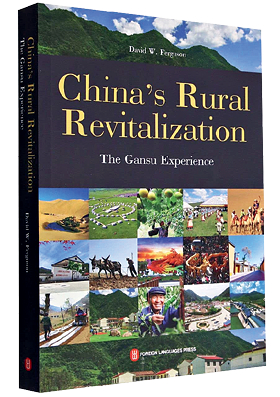
China’s Rural Revitalization: The Gansu Experience
Author: David W. Ferguson
Paperback, 334 Pages
Published by Foreign Languages Press
In 2021, President Xi Jinping announced the realization of China’s First Centenary Goal – building a moderately prosperous society in all respects. This success involved the elimination of absolute poverty in China, which was a step in a process rather than the end goal. Revitalization of once-impoverished rural areas is still underway.
China’s Rural Revitalization: The Gansu Experience sums up the social and economic development and poverty alleviation in China over the past seven decades. Specifically, it is also an account of poverty eradication and rural revitalization work at the grassroots in Gansu Province in northwest China.
The author David W. Ferguson came to China in 2006 and since 2010, has been a writer and editor with the Foreign Languages Press in Beijing. He is also one of the editors of the English edition of Xi Jinping: The Governance of China. Ferguson has won the Special Book Award of China, organized by the National Press and Publication Administration since 2005, and the Chinese Government Friendship Award for his work in promoting Chinese culture and bridging China and the English-speaking world.
The first part of the book gives a historical account of economic development and poverty alleviation in China since the founding of the People’s Republic of China (PRC) in 1949, summarizing the reasons behind the rising GDP figures.
He regards transport and supporting infrastructure as the foremost factor. It is essential that people and material goods can flow as freely and efficiently as possible, and that information can be communicated quickly and effectively. For example, in rural communities, the “last kilometer” to reach the destination is just as important as the first hundred. The construction of a huge network of rural roads has enabled village herders to take their livestock to the market, providing the momentum for their economic growth.
Moreover, China’s information technology and telecommunications achievements are unmatched anywhere else in the world. The author’s travels in Gansu took him to many remote mountainous areas, which are still the least developed places in China. But no matter how far he journeyed from the beaten track, he almost never lost his 4G connection, and most of the time he had a 5G signal.
Other key elements for the success in poverty alleviation include the mobilization of grassroots officials, renovation or replacement of dilapidated housing for the poor, encouraging entrepreneurs to start their own businesses, developing eco-friendly tourism, giving top priority to education, and e-commerce – which has enabled thousands of rural communities to promote their produce online and deliver it to a national, and even international, clientele.
In the second part of the book, the author talks about the different places he visited, such as the Zhongshan Bridge on the Yellow River in Lanzhou, the Lanzhou Museum complex, and the ancient town of Hekou, an important transportation hub in the Ming and Qing dynasties, and what he learned about the local people’s poverty alleviation and rural revitalization efforts.
After shaking off poverty in 2019, Yuangudui, a village in Gansu’s Dingxi City, has a new look. The first impression is of neatness. The roads are well-maintained, fields planted with a variety of crops in an orderly way, and the houses are modern and well laid-out. But just eight years ago, the impression would have been very different. Farmers eked out a subsistence-level living from growing basic staple crops such as potatoes, wheat and beans. When the farming season ended, there was no alternative employment, and villagers hung around with nothing to do.
Then came the visit on February 3, 2013, during the lunar New Year, by Xi Jinping, then the new general secretary of the Communist Party of China (CPC) Central Committee. Xi encouraged the locals to work hard together and this served as a nationwide declaration of the poverty alleviation battle. The drive involved Party members at every level, from the State Council Leading Group Office of Poverty Alleviation and Development to the village.
The CPC has a far more active and direct role in governance at the grassroot level than any Western political party. Yuangudui’s fields are suitable for growing potatoes and the high-quality seed potatoes promise business with great potential. Also, a new 20-hectare park has been built at the top of the village, with a free-range herd of 350 Sika deer. The park serves as both a tourist attraction and the source of a range of deer products, which has led to the creation of an online e-commerce store.
The third and final part, titled “The Strengths of China’s System,” details why the CPC could lead the people to win the battle against poverty – which seems unbelievable to many Westerners.
At the time of the PRC’s founding, China was one of the poorest countries in the world – poorer than sub-Saharan Africa. In the short seven decades of its existence, under the leadership of the CPC it has pulled itself up and evolved into a nation that has eliminated absolute poverty. The CPC’s leadership inspired, motivated, and mobilized the people while the government provided the resources to help the poor communities break out of the relentless cycle of poverty.
“To ensure that everyone leads a better life, we must never rest on what we have achieved, and there is still a long way to go,” President Xi said in his New Year address to the nation on December 31, 2021. Therefore, China has a new strategy – rural revitalization – which is being implemented in the areas that achieved their poverty alleviation goals comparatively earlier to ensure they don’t slide back into the pit again.